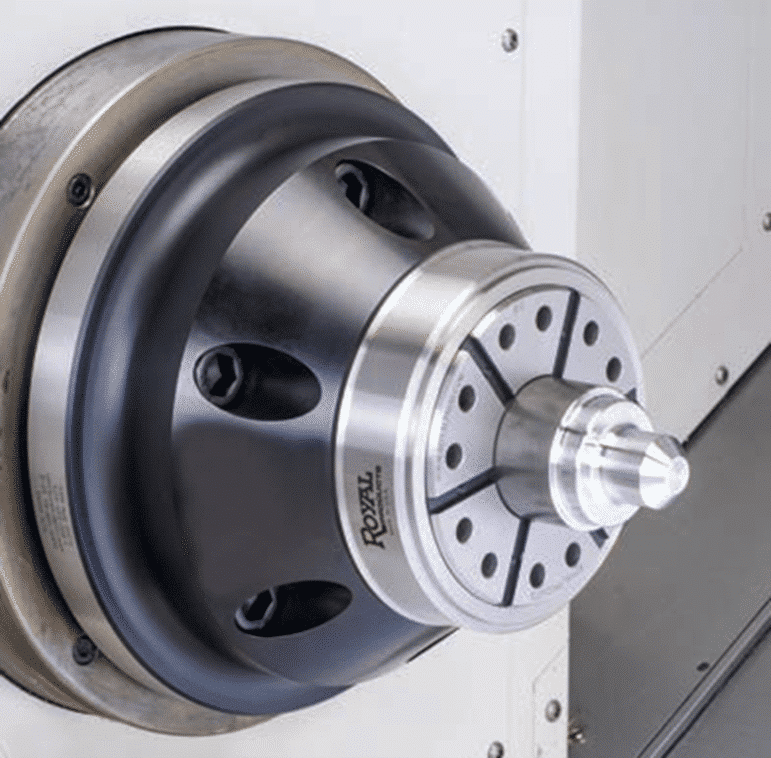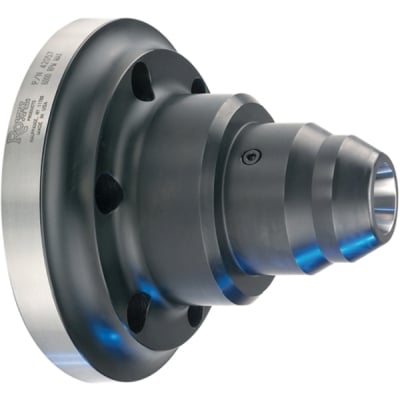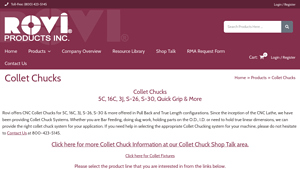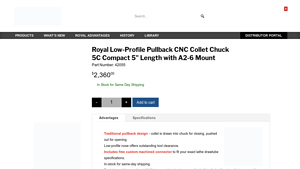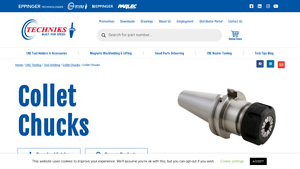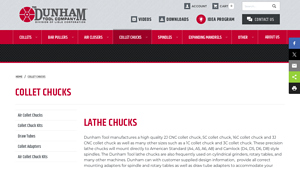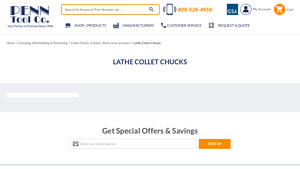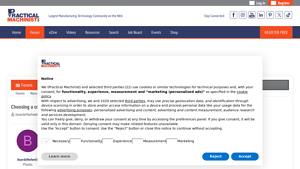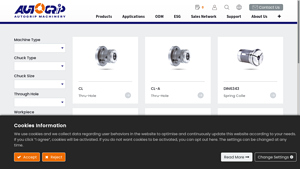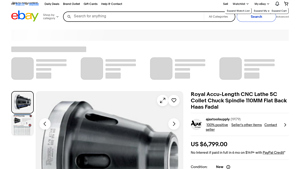Collet Chuck For Cnc Lathe Guide: Type, Cost, Top List…
Introduction: Navigating the Global Market for collet chuck for cnc lathe
In today’s competitive landscape, sourcing the right collet chuck for CNC lathes presents a significant challenge for B2B buyers across various industries. With a multitude of options available, from 5C and 16C configurations to specialized models like Quick Grip and Low-Profile, making an informed choice can be overwhelming. This comprehensive guide aims to simplify the decision-making process by exploring the diverse types of collet chucks, their applications in precision machining, and the essential criteria for supplier vetting.
International buyers, particularly those from regions such as Africa, South America, the Middle East, and Europe, including countries like Brazil and Germany, face unique market dynamics and logistical considerations. This guide not only addresses the technical specifications and operational benefits of different collet chucks but also delves into cost analysis and procurement strategies tailored to global buyers. By equipping you with actionable insights and expert recommendations, this resource empowers your organization to navigate the complexities of the collet chuck market confidently.
As you explore the nuances of collet chucks for CNC lathes, you’ll discover how to enhance productivity, ensure precision, and ultimately drive your manufacturing success. Whether you’re looking to optimize your current operations or expand your capabilities, this guide serves as a valuable tool in your strategic sourcing efforts.
Understanding collet chuck for cnc lathe Types and Variations
| Type Name | Key Distinguishing Features | Primary B2B Applications | Brief Pros & Cons for Buyers |
|---|---|---|---|
| 5C Collet Chuck | Versatile, widely used, holds workpieces up to 2″ diameter | General machining, tool holding | Pros: Cost-effective, easy to find; Cons: Limited gripping range compared to others. |
| 16C Collet Chuck | Larger capacity, suited for workpieces up to 3″ diameter | Heavy-duty applications, bar feeding | Pros: Greater gripping force; Cons: Heavier, may require more robust machines. |
| Quick-Grip Collet Chuck | Fast changeover, dead-length operation | High-volume production, rapid setups | Pros: Speed and efficiency; Cons: May have higher initial costs. |
| Low-Profile Collet Chuck | Compact design for tight spaces, excellent tool clearance | Medical device manufacturing, mold making | Pros: Ideal for limited space; Cons: May have lower clamping force. |
| Air Operated Collet Chuck | Pneumatic operation for quick adjustments | Automation, high-speed applications | Pros: Enhanced precision and speed; Cons: Requires compressed air supply. |
What are the Characteristics of the 5C Collet Chuck?
The 5C collet chuck is recognized for its versatility and is commonly used in various machining operations. It can accommodate workpieces up to 2 inches in diameter, making it ideal for general machining and tool holding. B2B buyers should consider the availability and cost-effectiveness of 5C collets, as they are widely produced and easy to source. However, the gripping range may be limited compared to larger collet types, which could affect applications requiring higher precision.
Why Choose the 16C Collet Chuck for Heavy-Duty Applications?
The 16C collet chuck is designed for heavier applications, capable of holding workpieces up to 3 inches in diameter. Its robust construction provides greater gripping force, making it suitable for bar feeding and heavy-duty machining. B2B buyers looking for durability and strength in their chuck systems will find the 16C an excellent choice. However, its increased weight and size may necessitate more powerful machinery, which is a critical consideration for buyers in sectors such as automotive and aerospace.
How Does the Quick-Grip Collet Chuck Enhance Production Efficiency?
The Quick-Grip collet chuck is engineered for rapid changeover, facilitating dead-length operation, which is essential in high-volume production environments. This chuck type is particularly advantageous for businesses focused on efficiency and speed, reducing downtime during setup. While the initial investment may be higher, the long-term productivity gains can justify the cost. B2B buyers should assess their production needs to determine if the speed benefits align with their operational goals.
What Advantages Does a Low-Profile Collet Chuck Offer?
Low-profile collet chucks are designed for applications where space is at a premium, offering excellent tool clearance. These chucks are particularly beneficial in industries like medical device manufacturing and mold making, where precision and compact setups are crucial. While they excel in tight spaces, buyers should be aware that their clamping force may be lower than other types, which could impact performance in high-load situations. B2B buyers must evaluate their specific machining needs to ensure compatibility.
Why Consider Air Operated Collet Chucks for Automation?
Air-operated collet chucks utilize pneumatic systems for quick adjustments, making them ideal for automated and high-speed applications. They provide enhanced precision and can significantly improve cycle times in production settings. For B2B buyers, the requirement for a compressed air supply is an important consideration, as it may entail additional infrastructure costs. However, the efficiency gains often make air-operated chucks a worthwhile investment in fast-paced manufacturing environments.
Key Industrial Applications of collet chuck for cnc lathe
| Industry/Sector | Specific Application of collet chuck for cnc lathe | Value/Benefit for the Business | Key Sourcing Considerations for this Application |
|---|---|---|---|
| Aerospace | Precision machining of turbine components | Enhanced accuracy and reduced material waste | Certification for aerospace standards and materials |
| Automotive | Production of engine parts and transmission components | Higher productivity and improved part consistency | Compatibility with various part sizes and types |
| Medical Devices | Manufacturing of surgical instruments and implants | Strict adherence to tolerances and safety standards | Biocompatibility and precision requirements |
| Mold and Die Manufacturing | Fabrication of molds for injection molding | Efficient production cycles and high repeatability | Customization options for specific mold designs |
| Electronics | Production of circuit board components and enclosures | Reduced cycle times and improved product quality | Need for specialized collet types for small components |
How is Collet Chuck Used in Aerospace Precision Machining?
In the aerospace sector, collet chucks are essential for the precision machining of turbine components, which require tight tolerances and high accuracy. These chucks allow for a secure grip on complex shapes and materials, minimizing vibration and enhancing the surface finish. For international buyers, sourcing collet chucks that meet aerospace standards is crucial, as certifications ensure compliance with safety regulations and quality assurance.
What Role Does Collet Chuck Play in Automotive Part Production?
Automotive manufacturers utilize collet chucks for the production of engine parts and transmission components, where efficiency and precision are paramount. The ability to quickly change tooling with collet chucks leads to increased productivity, while their superior gripping force ensures consistent part quality. Buyers in this sector should consider the chuck’s compatibility with various part sizes and the ease of integration into existing manufacturing systems.
Why Are Collet Chucks Important in Medical Device Manufacturing?
In the medical device industry, collet chucks facilitate the manufacturing of surgical instruments and implants that must adhere to strict tolerances and safety standards. These chucks provide a reliable grip on delicate components, ensuring high precision during machining processes. For B2B buyers, sourcing collet chucks that are biocompatible and meet regulatory requirements is critical for maintaining product integrity and safety.
How Do Collet Chucks Enhance Mold and Die Manufacturing?
Collet chucks are widely used in mold and die manufacturing to fabricate molds for injection molding processes. Their ability to hold various shapes securely allows for efficient production cycles and high repeatability. Buyers should look for customization options that accommodate specific mold designs, ensuring that the collet chuck can handle the unique demands of their production processes.
What Benefits Do Collet Chucks Offer in Electronics Production?
In the electronics industry, collet chucks are vital for the production of circuit board components and enclosures, where precision and speed are essential. The use of collet chucks reduces cycle times and enhances product quality by providing stable and accurate machining. International B2B buyers should focus on specialized collet types that cater to small components, ensuring optimal performance in high-speed applications.
3 Common User Pain Points for ‘collet chuck for cnc lathe’ & Their Solutions
Scenario 1: Inconsistent Workpiece Precision During Machining
The Problem:
Many B2B buyers experience challenges with maintaining precision during machining operations when using collet chucks. As businesses scale production, variations in workpiece dimensions can lead to significant quality issues, particularly for industries like aerospace or automotive, where tolerances are critical. A common complaint is that standard collet chucks may not provide the necessary grip or alignment, resulting in inaccuracies, especially at higher RPMs. This can lead to increased scrap rates and rework, driving up production costs and time.
The Solution:
To address precision issues, buyers should consider investing in high-quality, precision-engineered collet chucks that offer superior gripping force and alignment capabilities. For instance, using collet chucks with advanced designs like the Quick-Grip™ models can enhance gripping power significantly compared to standard options. Additionally, proper setup is crucial; ensure that the collet is correctly seated and that the chuck is maintained regularly to prevent wear and tear. Implementing a routine check for collet wear and ensuring that the correct collet size is used for each application will also contribute to maintaining precision and reducing scrap.
Scenario 2: Frequent Tool Change Delays Impacting Productivity
The Problem:
In high-volume machining environments, delays during tool changes can severely impact overall productivity. Many buyers find that traditional collet chucks require significant time and effort to change, particularly when switching between different workpiece sizes or types. This inefficiency can lead to extended machine downtime and reduced throughput, ultimately affecting profitability.
The Solution:
To minimize tool change delays, buyers should explore collet chuck systems designed for quick changeovers, such as those with a dead-length operation feature. These systems allow for fast and efficient part positioning, reducing the time spent on adjustments. Moreover, investing in modular collet chuck systems can provide the flexibility needed to accommodate various sizes and types of tools without the need for extensive recalibration. Training operators on efficient tool change techniques and maintaining a well-organized tool storage system can also streamline the process, further enhancing productivity.
Scenario 3: Limited Compatibility with Existing Machinery
The Problem:
B2B buyers often face compatibility issues when sourcing collet chucks for their CNC lathes. Many collet chuck systems are not designed to fit various lathe models, leading to frustration and additional costs associated with modifications or replacements. This is particularly challenging for buyers in regions with diverse machinery, where standardization may not be possible.
The Solution:
To avoid compatibility issues, it is essential for buyers to conduct thorough research before purchasing collet chucks. They should identify the specific requirements of their CNC lathe, including spindle types and drawtube specifications. Opting for manufacturers that offer customizable solutions or a wide range of collet styles can significantly mitigate these issues. Additionally, engaging with suppliers who provide expert consultation can help buyers select the right collet chuck that fits their machinery, ensuring seamless integration and optimal performance. Keeping an open line of communication with suppliers regarding future upgrades or changes in machinery can also help in sourcing compatible solutions effectively.
Strategic Material Selection Guide for collet chuck for cnc lathe
When selecting a collet chuck for CNC lathes, the choice of material is crucial as it directly affects performance, durability, and cost-effectiveness. Below, we analyze four common materials used in collet chuck manufacturing, focusing on their properties, advantages, disadvantages, and implications for international B2B buyers.
What Are the Key Properties of Steel for Collet Chucks?
Steel, particularly high-carbon and alloy steels, is a popular choice for collet chucks due to its excellent mechanical properties. It offers high tensile strength, durability, and resistance to wear, making it suitable for high-pressure applications. Steel can withstand elevated temperatures, which is beneficial in high-speed machining environments.
Pros and Cons:
While steel provides robust performance, it is prone to corrosion if not properly treated. The manufacturing process can be complex, requiring advanced machining techniques. However, the end product is generally cost-effective and widely accepted in various industries.
Impact on Application:
Steel collet chucks are compatible with a wide range of media, including metals and plastics, making them versatile for different machining tasks.
Considerations for International Buyers:
Buyers from regions like Europe and South America should ensure compliance with DIN and ASTM standards for quality assurance. Corrosion-resistant coatings may be necessary in humid climates, particularly in Africa and the Middle East.
How Does Aluminum Compare as a Material for Collet Chucks?
Aluminum is another material used in collet chuck production, especially in applications requiring lightweight components. It has a lower density than steel, which can enhance machine performance by reducing inertia.
Pros and Cons:
Aluminum offers good corrosion resistance and is easier to machine, leading to lower manufacturing costs. However, it has lower tensile strength compared to steel, which may limit its use in high-load applications.
Impact on Application:
Aluminum collet chucks are ideal for lighter workpieces and applications where weight reduction is critical. They are less suitable for heavy-duty machining tasks.
Considerations for International Buyers:
Buyers should be aware of specific aluminum grades that meet international standards, such as JIS and ASTM. In regions with high humidity, additional surface treatments may be necessary to enhance corrosion resistance.
What Are the Benefits of Using Titanium for Collet Chucks?
Titanium is recognized for its exceptional strength-to-weight ratio and corrosion resistance, making it an excellent choice for specialized applications. It can withstand high temperatures and is highly resistant to wear.
Pros and Cons:
While titanium offers superior performance, it is significantly more expensive than steel and aluminum, which can impact overall project budgets. The manufacturing process is also more complex, requiring specialized equipment.
Impact on Application:
Titanium collet chucks are particularly beneficial in aerospace and medical applications where precision and durability are paramount.
Considerations for International Buyers:
Buyers should consider the higher costs and ensure that their suppliers can meet stringent quality standards, especially in industries like aerospace, which often require compliance with international regulations.
How Do Composite Materials Enhance Collet Chuck Performance?
Composite materials, such as carbon fiber-reinforced plastics, are increasingly being used in collet chuck applications due to their lightweight and high-strength properties. They can provide excellent vibration dampening, which is crucial for precision machining.
Pros and Cons:
Composites are resistant to corrosion and can be manufactured with complex geometries. However, they may not be suitable for high-temperature applications and can be more expensive due to specialized manufacturing processes.
Impact on Application:
Composite collet chucks are ideal for high-speed machining of non-metallic materials, where weight savings can enhance performance.
Considerations for International Buyers:
When sourcing composite materials, buyers should verify compliance with international standards and consider the specific needs of their applications, particularly in high-precision industries.
Summary Table of Material Selection for Collet Chucks
| Material | Typical Use Case for collet chuck for cnc lathe | Key Advantage | Key Disadvantage/Limitation | Relative Cost (Low/Med/High) |
|---|---|---|---|---|
| Steel | General machining, high-load applications | High strength and durability | Prone to corrosion without treatment | Medium |
| Aluminum | Lightweight applications, non-heavy machining | Corrosion resistance, lightweight | Lower tensile strength | Low |
| Titanium | Aerospace, medical applications | Excellent strength-to-weight ratio | High cost, complex manufacturing | High |
| Composite | High-speed machining of non-metallic materials | Lightweight, vibration dampening | Limited high-temperature suitability | Medium to High |
This strategic material selection guide provides valuable insights for international B2B buyers, enabling informed decisions that align with their specific operational needs and regional compliance requirements.
In-depth Look: Manufacturing Processes and Quality Assurance for collet chuck for cnc lathe
What Are the Key Stages in the Manufacturing Process of Collet Chucks for CNC Lathes?
The manufacturing process for collet chucks, particularly those designed for CNC lathes, involves several critical stages to ensure precision and reliability. These stages include material preparation, forming, assembly, and finishing.
-
Material Preparation: The process begins with selecting high-grade materials, typically high-carbon steel or alloy steel, known for their strength and durability. The raw materials undergo rigorous inspection to ensure they meet specified chemical and mechanical properties. This stage may also involve cutting the materials into manageable sizes for subsequent processing.
-
Forming: During this phase, the prepared materials are subjected to various forming techniques such as forging, machining, and heat treatment. Forging provides the necessary strength and toughness, while machining, often done using CNC machines, shapes the components to precise dimensions. Heat treatment is then applied to enhance hardness and wear resistance, which is essential for high-performance applications.
-
Assembly: The assembly stage involves the integration of different components such as the collet body, nut, and clamping mechanism. Precision in this stage is paramount, as misalignments can lead to significant performance issues. Automated assembly lines are often employed to maintain consistency and accuracy, reducing the risk of human error.
-
Finishing: Finally, the collet chucks undergo finishing processes, including surface treatment and coating. Techniques such as grinding and polishing are used to achieve the desired surface finish, while coatings may be applied for corrosion resistance and improved aesthetics.
What Quality Assurance Practices Should Be Considered in Collet Chuck Manufacturing?
Quality assurance (QA) is a crucial element in the manufacturing of collet chucks, ensuring that the final products meet international and industry-specific standards.
-
Relevant International Standards: Manufacturers should adhere to ISO 9001, which sets the criteria for a quality management system. This standard focuses on consistent quality and customer satisfaction. Additionally, compliance with CE marking indicates that the product meets EU safety, health, and environmental protection standards. For specific industries, certifications like API (American Petroleum Institute) may also be relevant.
-
Quality Control Checkpoints: Quality control is typically structured around several key checkpoints:
– Incoming Quality Control (IQC): This involves inspecting raw materials before they enter production to ensure they meet specifications.
– In-Process Quality Control (IPQC): This stage monitors the manufacturing process through regular inspections and tests to catch defects early.
– Final Quality Control (FQC): Once the collet chucks are assembled and finished, a thorough inspection is conducted to ensure they meet all quality standards before shipping. -
Common Testing Methods: Various testing methods are employed to verify the performance and reliability of collet chucks, including:
– Dimensional Inspection: Using precision measuring instruments to ensure all components meet specified tolerances.
– Functional Testing: Assessing the performance of the collet chuck under simulated operational conditions.
– Material Testing: Conducting tests such as hardness and tensile strength to validate material properties.
How Can B2B Buyers Verify Supplier Quality Control?
For B2B buyers, particularly those in regions such as Africa, South America, the Middle East, and Europe, verifying a supplier’s quality control processes is essential to ensure reliability and performance.
-
Supplier Audits: Conducting audits of potential suppliers can provide deep insights into their manufacturing processes and quality assurance practices. This can include reviewing documentation related to their quality management systems, inspection reports, and certifications.
-
Requesting Quality Reports: Buyers should request detailed quality reports that outline the results of various testing methods applied throughout the manufacturing process. This transparency can help in assessing the reliability of the products.
-
Third-Party Inspections: Engaging third-party inspection services can offer an unbiased evaluation of the supplier’s quality control measures. These inspections can validate compliance with international standards and provide assurance that the products meet specified requirements.
What Are the Nuances of Quality Control and Certification for International Buyers?
International B2B buyers must be aware of specific nuances related to quality control and certification when sourcing collet chucks.
-
Understanding Regional Standards: Different regions may have varying quality standards and certifications. For example, European buyers may prioritize CE marking, while buyers in the Middle East might look for compliance with local regulations. Understanding these nuances can help buyers make informed purchasing decisions.
-
Language and Documentation Barriers: Language differences can pose challenges when reviewing quality control documentation. Buyers should ensure that all technical documents are available in a language they understand to avoid misinterpretations.
-
Cultural Differences in Business Practices: Different regions may have varying approaches to quality assurance and manufacturing processes. Building strong relationships with suppliers can facilitate better communication and understanding of quality expectations.
Conclusion
The manufacturing processes and quality assurance practices for collet chucks used in CNC lathes are critical for ensuring product reliability and performance. By understanding these processes, B2B buyers can make informed decisions when sourcing collet chucks, ultimately leading to improved operational efficiency and product quality in their own manufacturing environments. Establishing robust quality verification methods will further enhance buyer confidence in their suppliers, fostering long-term partnerships that are beneficial for both parties.
Practical Sourcing Guide: A Step-by-Step Checklist for ‘collet chuck for cnc lathe’
In the competitive landscape of CNC machining, selecting the right collet chuck is essential for optimizing productivity and ensuring precision. This guide provides a practical checklist for B2B buyers to streamline their sourcing process for collet chucks suitable for CNC lathes.
Step 1: Define Your Technical Specifications
Establishing clear technical specifications is the foundation of your sourcing process. Consider the size and type of collet chucks compatible with your CNC lathe, including 5C, 16C, or 3J types. Additionally, assess the gripping range, drawbar force, and RPM requirements to ensure the selected collet chuck meets your operational needs.
Step 2: Research Available Collet Chuck Types
Understanding the different types of collet chucks available can significantly impact your choice. Investigate options such as pull-back, true length, and air-operated chucks, as each type offers unique advantages. For instance, air-operated chucks may provide quicker changeovers, while true length chucks ensure precise part positioning.
Step 3: Evaluate Supplier Certifications
Before finalizing a supplier, verify their certifications and industry standards compliance. Check for ISO certifications or other relevant quality assurances that demonstrate their commitment to manufacturing excellence. This step ensures that the collet chucks you receive are reliable and meet international quality benchmarks.
Step 4: Request Samples and Product Demonstrations
Requesting samples or product demonstrations is critical to assess the performance of the collet chucks in your specific applications. This allows you to evaluate the gripping force, tool clearance, and ease of operation firsthand. Take note of how the chuck performs under various conditions, particularly at high RPMs or during heavy loads.
Step 5: Compare Pricing and Terms of Sale
Gather quotes from multiple suppliers to compare pricing structures and terms of sale. Look beyond the initial cost; consider factors such as warranty, after-sales support, and potential bulk purchase discounts. A comprehensive understanding of the total cost of ownership will help you make a more informed decision.
Step 6: Check Customer Reviews and Case Studies
Investigating customer reviews and case studies can provide valuable insights into a supplier’s reliability and product performance. Look for feedback from buyers in similar industries or geographical regions to gauge compatibility with your needs. Positive reviews can indicate a supplier’s commitment to customer satisfaction and product quality.
Step 7: Finalize the Purchase and Confirm Delivery Terms
Once you have evaluated all options, finalize your purchase agreement and confirm the delivery terms. Ensure that the supplier provides a clear timeline for delivery and discuss any potential for delays. This step is crucial to maintaining your production schedule and minimizing downtime in your operations.
By following these steps, B2B buyers can effectively navigate the sourcing process for collet chucks, ensuring they select the right components that enhance their CNC machining capabilities.
Comprehensive Cost and Pricing Analysis for collet chuck for cnc lathe Sourcing
What Are the Key Cost Components in Sourcing Collet Chucks for CNC Lathes?
When evaluating the cost structure of collet chucks for CNC lathes, several components contribute to the overall price. Key elements include:
-
Materials: High-quality materials such as alloy steel or hardened steel are often used in manufacturing collet chucks. The choice of materials significantly affects durability and performance, and thus the cost.
-
Labor: Labor costs can vary based on the complexity of the manufacturing process. Skilled labor is often required for precise machining and assembly, which can drive up costs.
-
Manufacturing Overhead: This includes expenses related to factory operations, utilities, equipment maintenance, and depreciation. Companies with advanced manufacturing technologies may have lower overhead per unit, impacting pricing.
-
Tooling: Specialized tooling for producing collet chucks can be expensive. The amortization of these costs across production volumes will influence the final price.
-
Quality Control (QC): Rigorous quality checks are essential to ensure that collet chucks meet industry standards. This process adds to the overall cost but is crucial for maintaining reliability and performance.
-
Logistics: Shipping costs can vary significantly depending on the distance, mode of transport, and whether the goods are shipped as part of a larger order. International logistics may introduce additional costs, such as customs duties and tariffs.
-
Margin: Supplier margins can vary widely based on brand reputation, market demand, and competition. Understanding the margin applied can help buyers gauge whether they are receiving a fair price.
How Do Price Influencers Affect Collet Chuck Sourcing?
Several factors can influence the pricing of collet chucks in a B2B context:
-
Volume and Minimum Order Quantity (MOQ): Suppliers often provide better pricing for larger orders. Understanding the MOQ can help buyers negotiate better terms.
-
Specifications and Customization: Custom-designed collet chucks tailored to specific applications can lead to higher costs. Buyers should balance the need for customization with budget constraints.
-
Material Quality and Certifications: Collet chucks made from higher-grade materials with certifications (e.g., ISO) typically command higher prices due to their enhanced performance and reliability.
-
Supplier Factors: The reputation and reliability of the supplier can impact pricing. Established suppliers may charge a premium for their products due to perceived value and trustworthiness.
-
Incoterms: The chosen Incoterms (International Commercial Terms) can significantly affect overall costs. Buyers should be aware of who bears the shipping costs and risks, which can alter the total cost of acquisition.
What Buyer Tips Can Enhance Cost-Efficiency When Sourcing Collet Chucks?
International B2B buyers, particularly from regions like Africa, South America, the Middle East, and Europe, should consider the following strategies to enhance cost-efficiency:
-
Negotiation: Approach suppliers with a clear understanding of market prices and be prepared to negotiate. Leveraging multiple quotes can provide leverage in negotiations.
-
Total Cost of Ownership (TCO): Beyond the purchase price, consider the total cost of ownership, including maintenance, downtime, and replacement costs. Investing in higher-quality collet chucks may reduce overall expenses in the long run.
-
Pricing Nuances for International Buyers: Be aware of currency fluctuations and their impact on pricing. Additionally, understand regional differences in pricing strategies and supply chain dynamics.
-
Supplier Relationships: Building long-term relationships with suppliers can lead to better pricing, priority service, and insights into new products or technologies.
-
Market Trends: Stay informed about market trends and technological advancements in collet chuck design and materials. This knowledge can empower buyers to make informed purchasing decisions and potentially negotiate better terms.
Disclaimer on Indicative Prices
While indicative prices for collet chucks can range significantly based on the aforementioned factors, it is essential to consult suppliers directly for accurate quotes tailored to specific needs. Prices can fluctuate based on market conditions, availability, and changes in material costs. Always conduct thorough due diligence before finalizing any procurement decisions.
Alternatives Analysis: Comparing collet chuck for cnc lathe With Other Solutions
Introduction to Alternative Solutions for CNC Lathe Workholding
When it comes to securing workpieces on CNC lathes, collet chucks are a popular choice due to their precision and versatility. However, various alternative solutions exist that may be better suited for specific applications or operational needs. Understanding these alternatives can help B2B buyers make informed decisions based on performance, cost, and application requirements.
Comparison Table of Workholding Solutions
| Comparison Aspect | Collet Chuck For CNC Lathe | Three-Jaw Chuck | Hydraulic Chuck |
|---|---|---|---|
| Performance | High precision, excellent for small parts | Good for larger and irregular shapes | Very high gripping force, ideal for heavy loads |
| Cost | Moderate to high ($300 – $4,000+) | Generally lower ($100 – $1,500) | Higher initial investment ($1,000 – $5,000) |
| Ease of Implementation | Requires specific collet types and setup | Simple to install, universal fit | More complex installation and setup |
| Maintenance | Low, occasional collet replacement | Moderate, requires regular adjustments | Higher, needs periodic hydraulic system checks |
| Best Use Case | Small to medium parts, high precision applications | General machining, larger parts | Heavy-duty applications, where high torque is needed |
In-Depth Analysis of Alternatives
Three-Jaw Chuck
Three-jaw chucks are one of the most common alternatives to collet chucks. They are versatile and can handle a wide range of workpiece shapes and sizes, making them suitable for general machining tasks. While they offer ease of use and installation, their gripping precision is not as high as collet chucks, especially for smaller components. Additionally, the gripping force can vary depending on the workpiece shape, which may lead to inaccuracies in high-speed operations.
Hydraulic Chuck
Hydraulic chucks provide a robust solution for securing larger and heavier workpieces. They utilize hydraulic pressure to achieve a very high gripping force, which minimizes the risk of workpiece slippage during machining. This makes them ideal for applications requiring significant torque. However, hydraulic chucks can be more complex to install and maintain, as they require a hydraulic system and regular checks to ensure functionality. Their higher initial cost may also deter some buyers, particularly those with tighter budgets.
Conclusion: Choosing the Right Workholding Solution
Selecting the right workholding solution for CNC lathe operations depends on various factors, including the specific application, budget constraints, and desired performance levels. Collet chucks are an excellent choice for precision work with smaller parts, while three-jaw chucks offer flexibility for larger components. For heavy-duty tasks, hydraulic chucks are superior due to their gripping power. By evaluating these alternatives based on the outlined criteria, B2B buyers can make informed decisions that align with their operational goals and enhance overall machining efficiency.
Essential Technical Properties and Trade Terminology for collet chuck for cnc lathe
What Are the Key Technical Properties of Collet Chucks for CNC Lathes?
When selecting a collet chuck for CNC lathes, understanding specific technical properties is crucial for ensuring compatibility, efficiency, and overall performance. Here are some essential specifications:
1. Material Grade
Collet chucks are typically made from high-grade steel or aluminum alloys. The choice of material affects durability, weight, and resistance to wear. For instance, high-carbon steel provides superior strength and longevity, making it ideal for heavy-duty applications. B2B buyers should consider material grade to ensure the chuck can withstand the operational demands of their specific machining tasks.
2. Tolerance
Tolerance refers to the permissible limit of variation in a physical dimension. High tolerance levels are critical for precision machining, as they ensure that the workpiece is held securely and accurately. A collet chuck with tight tolerances minimizes runout, which is essential for achieving high-quality finishes and maintaining part consistency. Buyers should prioritize collets with specified tolerances that align with their production standards.
3. Clamping Force
The clamping force indicates how securely a collet chuck can grip a workpiece. This specification is vital for maintaining stability during high-speed operations. Chucks designed for high RPM applications typically offer greater clamping force, reducing the likelihood of slippage and ensuring safer machining conditions. B2B buyers must assess clamping force relative to their operational requirements, especially when handling larger or heavier workpieces.
4. Maximum RPM
This specification defines the highest rotational speed at which the collet chuck can operate safely. Higher RPM ratings are essential for applications requiring fast machining cycles. Buyers should ensure that the collet chuck selected can accommodate the speeds necessary for their production processes, particularly in industries such as aerospace and automotive, where precision and efficiency are paramount.
5. Chuck Style
Different chuck styles, such as pull-back and true-length, cater to specific machining needs. Pull-back chucks are ideal for applications requiring minimal protrusion, while true-length chucks provide precise axial positioning. Understanding the differences in chuck styles helps buyers select the most appropriate option for their specific lathe configurations and machining tasks.
What Are Common Trade Terms Related to Collet Chucks for CNC Lathes?
Familiarity with industry jargon can enhance communication and negotiation processes in B2B transactions. Here are some common terms:
1. OEM (Original Equipment Manufacturer)
An OEM is a company that produces parts or equipment that may be marketed by another manufacturer. In the context of collet chucks, knowing whether the supplier is an OEM can indicate the quality and reliability of the products offered. B2B buyers often prefer OEM products for their assurance of compatibility and performance.
2. MOQ (Minimum Order Quantity)
MOQ refers to the smallest amount of a product that a supplier is willing to sell. Understanding MOQ is essential for buyers to plan their inventory and budget effectively. Suppliers may set MOQs to ensure cost-effectiveness in manufacturing and shipping, so buyers should negotiate based on their needs.
3. RFQ (Request for Quotation)
An RFQ is a document used by buyers to solicit price quotes from suppliers. It typically includes details about the desired products, quantities, and specifications. Submitting an RFQ is a crucial step in the purchasing process, allowing buyers to compare prices and terms across multiple vendors.
4. Incoterms (International Commercial Terms)
Incoterms are a set of standardized terms used in international trade to define the responsibilities of buyers and sellers in shipping goods. Understanding these terms is vital for B2B transactions, as they clarify who is responsible for shipping, insurance, and tariffs. This knowledge helps prevent misunderstandings and ensures smooth logistics.
5. Drawbar Force
This term refers to the force exerted by the drawbar mechanism to engage the collet chuck. A higher drawbar force ensures better grip and stability during machining operations. Buyers should consider this specification when selecting collet chucks for high-speed applications to mitigate the risk of tool slippage.
By understanding these technical properties and industry terms, B2B buyers can make informed decisions when purchasing collet chucks for CNC lathes, ultimately enhancing their machining capabilities and operational efficiency.
Navigating Market Dynamics and Sourcing Trends in the collet chuck for cnc lathe Sector
What are the Current Trends Shaping the Collet Chuck Market for CNC Lathes?
The global collet chuck market for CNC lathes is witnessing significant growth driven by advancements in manufacturing technology and increasing demand for precision machining. Industries such as aerospace, automotive, and medical are particularly focused on enhancing productivity and reducing downtime, leading to a surge in the adoption of high-performance collet chucks. Key trends include the shift towards automation, where manufacturers are integrating collet chucks into automated CNC systems to improve operational efficiency. Additionally, the rise of Industry 4.0 is pushing manufacturers to leverage data analytics and IoT capabilities, allowing for real-time monitoring and maintenance of collet chuck systems.
For international B2B buyers, particularly in regions like Africa, South America, the Middle East, and Europe, understanding local market dynamics is crucial. Countries like Brazil and Germany are investing heavily in CNC technology, thus creating a robust demand for innovative collet chuck solutions. Buyers should be aware of the competitive landscape, which includes both established manufacturers and emerging players offering cost-effective solutions. Furthermore, the importance of customization is growing, with businesses seeking tailored collet chuck systems that fit specific machining requirements.
How are Sustainability and Ethical Sourcing Impacting the Collet Chuck Market?
Sustainability is becoming an essential consideration for B2B buyers in the collet chuck sector. As industries face increasing scrutiny regarding their environmental impact, there is a growing demand for ethically sourced and sustainable products. Buyers are encouraged to seek suppliers who prioritize eco-friendly practices, such as using recyclable materials and minimizing waste during production.
Incorporating ‘green’ certifications into purchasing decisions can help businesses align with global sustainability goals. Certifications such as ISO 14001 for environmental management or materials sourced from certified suppliers can enhance a company’s reputation and appeal to environmentally conscious clients. Additionally, suppliers that demonstrate a commitment to sustainability are often more resilient and adaptable to regulatory changes, making them attractive partners for long-term collaborations.
How Have Collet Chucks Evolved Over Time to Meet Industry Demands?
The evolution of collet chucks has been driven by the need for precision and efficiency in machining processes. Initially, collet chucks were simple devices used primarily for holding round workpieces. However, advancements in materials and manufacturing techniques have led to the development of high-performance collet systems capable of withstanding higher speeds and loads.
Modern collet chucks now feature designs that enhance gripping force, reduce vibration, and allow for quick changeovers, which are critical in high-production environments. Innovations like low-profile designs and specialized configurations have also emerged to cater to diverse machining applications, reflecting the growing complexity of manufacturing processes. For B2B buyers, understanding these advancements is vital for selecting the most suitable collet chuck systems that align with their operational goals.
Frequently Asked Questions (FAQs) for B2B Buyers of collet chuck for cnc lathe
-
How do I solve issues with collet chuck misalignment?
To address collet chuck misalignment, first ensure that the collet is properly seated and tightened according to the manufacturer’s specifications. Check for any debris or wear on the chuck or collet that may hinder alignment. If problems persist, consider using precision alignment tools or jigs to adjust the setup. Regular maintenance and inspection can prevent misalignment issues, ensuring optimal performance and accuracy during machining operations. -
What is the best collet chuck type for CNC lathes?
The ideal collet chuck for CNC lathes depends on your specific machining requirements. For high-speed applications, consider low-profile or quick-grip collet chucks that offer superior gripping force and tool clearance. If you’re working with larger diameters, pull-back collet chucks are recommended for their stability. Evaluate factors such as the part size, material, and operational speed to determine the best collet chuck for your needs. -
What should I consider when vetting suppliers for collet chucks?
When vetting suppliers, assess their industry reputation, experience, and customer reviews. Ensure they provide detailed product specifications, certifications, and compliance with international standards. Request samples to evaluate quality and performance. Additionally, inquire about their manufacturing processes, lead times, and after-sales support. A supplier with a robust quality assurance program and responsive customer service can significantly enhance your sourcing experience. -
What are common customization options for collet chucks?
Many manufacturers offer customization options for collet chucks, including specific sizes, materials, and gripping ranges tailored to your application. You can also request modifications such as special coatings for enhanced durability or adjustments to fit unique spindle designs. Discuss your requirements with the supplier to explore available options and ensure the collet chuck meets your precise machining needs. -
What is the minimum order quantity (MOQ) for collet chucks?
Minimum order quantities can vary significantly between suppliers. Typically, MOQs range from 10 to 100 units, depending on the product line and the supplier’s production capabilities. Discuss your needs with potential suppliers, as some may offer flexibility for smaller orders, especially for custom or specialized collet chucks. Understanding MOQ is crucial for budgeting and inventory management in your operations. -
What payment terms should I expect when purchasing collet chucks internationally?
Payment terms for international purchases of collet chucks can include options such as advance payment, net 30/60 days, or letters of credit. It’s essential to clarify payment methods, currency, and any associated fees upfront. Some suppliers may require a deposit for large orders, while others might offer financing options. Ensure you fully understand the terms to avoid any cash flow issues during the procurement process. -
How can I ensure quality assurance for collet chucks?
To ensure quality assurance, request documentation such as inspection reports, certifications, and compliance with international standards from your supplier. Consider suppliers that implement rigorous quality control measures, including in-process inspections and final testing. Establishing a clear return policy and warranty can also protect your investment and ensure you receive high-quality products that meet your specifications. -
What logistics considerations should I keep in mind when sourcing collet chucks?
When sourcing collet chucks, consider shipping methods, lead times, and customs regulations that may impact delivery. Discuss logistics with your supplier to understand their shipping options and any additional costs involved. Ensure that you have a clear plan for customs clearance to avoid delays. Additionally, consider using a freight forwarder to streamline the shipping process and mitigate risks associated with international logistics.
Important Disclaimer & Terms of Use
⚠️ Important Disclaimer
The information provided in this guide, including content regarding manufacturers, technical specifications, and market analysis, is for informational and educational purposes only. It does not constitute professional procurement advice, financial advice, or legal advice.
While we have made every effort to ensure the accuracy and timeliness of the information, we are not responsible for any errors, omissions, or outdated information. Market conditions, company details, and technical standards are subject to change.
B2B buyers must conduct their own independent and thorough due diligence before making any purchasing decisions. This includes contacting suppliers directly, verifying certifications, requesting samples, and seeking professional consultation. The risk of relying on any information in this guide is borne solely by the reader.
Top 9 Collet Chuck For Cnc Lathe Manufacturers & Suppliers List
1. Rovi – CNC Collet Chucks
Domain: roviproducts.com
Registered: 1997 (28 years)
Introduction: Rovi offers CNC Collet Chucks for 5C, 16C, 3J, S-26, S-30 & more in Pull Back and True Length configurations. Products include:
– Atlas Air Powered Front Mount 5C Dead Length Collet Chucks ($299.00 – $3,594.00)
– Atlas Air Powered Front Mount 16C Dead Length Collet Chucks ($299.00 – $3,960.00)
– Wrench Operated and Manual Collet Chucks for 5C, 16C & 3J (price upon inquiry)
– Sjogren Speed Manual …
2. Royal Products – Low-Profile Pullback CNC Collet Chuck
Domain: royalproducts.com
Registered: 2001 (24 years)
Introduction: {“Product Name”: “Royal Low-Profile Pullback CNC Collet Chuck”, “Part Number”: “42055”, “Category”: [“Collet Chucks”, “Royal Low-Profile 5C, 16C, & 3J Pullback CNC Collet Chucks”, “Royal Low-Profile CNC Collet Chucks”], “Price”: “$2,360.00”, “Availability”: “In Stock for Same Day Shipping”, “Weight (lbs)”: 17, “Spindle Type”: “A2-6”, “Collet Type”: “5C”, “Low-Profile Capacity”: “1 1/16″”, “Overall…
3. Techniks – Certified Collet Chucks
Domain: techniksusa.com
Registered: 2000 (25 years)
Introduction: Techniks Certified Collet Chucks are balanced to 25,000 RPM @ G2.5 for high-speed applications. They are suitable for milling, drilling, and tapping. Features include PowerCOAT nuts for 75% more holding power, through-spindle and CoolFLEX AD+B flange coolant delivery options, and DualDRIVE design for superior rigidity. Extended gage lengths are available for long reach applications, while Super Ri…
4. Dunham Tool – CNC Collet Chucks
Domain: dunhamtool.com
Registered: 1999 (26 years)
Introduction: Dunham Tool manufactures high quality CNC collet chucks including 2J, 5C, 16C, and 3J sizes, as well as 1C and 3C collet chucks. These precision lathe chucks mount directly to American Standard (A4, A5, A6, A8) and Camlock (D4, D5, D6, D8) style spindles. They are suitable for use on cylindrical grinders, rotary tables, and other machines. Custom mounting adapters for spindles and rotary tables, a…
5. Royal – Quick-Grip™ Pullback CNC Collet Chuck
Domain: penntoolco.com
Registered: 1997 (28 years)
Introduction: This company, Royal – Quick-Grip™ Pullback CNC Collet Chuck, is a notable entity in the market. For specific product details, it is recommended to visit their website directly.
6. Royal Collet Chuck – Enhanced CNC Lathe Performance
Domain: reddit.com
Registered: 2005 (20 years)
Introduction: Royal collet chuck for CNC lathe; designed for one-off prototype work; users report improved setup times and accuracy; experiences shared indicate significant benefits over traditional 3-jaw chucks; noted for quick change capabilities; requires cleanliness during installation to function properly; recommended to use high-quality collets to achieve rated runout; Royal is praised for customer servic…
7. Practical Machinist – Collet Systems and Lathe Specs
Domain: practicalmachinist.com
Registered: 2000 (25 years)
Introduction: Collet system options: ER, 5C; Lathe specifications: Emco Maximat Super 11 (11″x25″, Morse taper number 4 spindle); Advantages of collets: quick and precise holding of round work, speed for multiple parts; 5C advantages: holds hex, square, or rectangular work, special collets available; Considerations: 3-jaw and 4-jaw chucks may suffice for occasional use; Using mill’s collet chuck on lathe: possi…
8. AUTOGRIP® – High-Performance Collet Chucks
Domain: autogrip-machinery.com
Registered: 2015 (10 years)
Introduction: AUTOGRIP® is a well-known collet chuck manufacturer in Taiwan, providing higher clamping force and faster speed than traditional collet chucks. The mechanism is activated by the inner collet bushing, which changes the taper and drives the inner elastic collet to clamp the workpiece. Features include a short profile to reduce tool interference, waterproof design to prevent cutting fluid from enteri…
9. Royal Products – Royal Accu-Length CNC Lathe 5C Collet Chuck Spindle
Domain: ebay.com
Registered: 1995 (30 years)
Introduction: {“Product Name”: “Royal Accu-Length CNC Lathe 5C Collet Chuck Spindle 110MM Flat Back Haas Fadal”, “Condition”: “New”, “Price”: “$6,799.00”, “Location”: “Carrollton, Ohio, United States”, “Shipping”: “May not ship to Brazil”, “Returns”: “Seller does not accept returns”, “Brand”: “Royal Products”, “Collet Chuck Type”: “5C Collet Chuck”, “Manufacturer Part Number (MPN)”: “42334”, “Country/Region of …
Strategic Sourcing Conclusion and Outlook for collet chuck for cnc lathe
In the competitive landscape of CNC machining, strategic sourcing of collet chucks is pivotal for enhancing operational efficiency and maintaining product quality. By understanding the diverse types of collet chucks, such as 5C, 16C, and specialized models like low-profile and quick-grip options, international B2B buyers can make informed decisions tailored to their specific machining needs. Prioritizing factors such as gripping force, tool clearance, and ease of changeover can lead to significant productivity gains and reduced downtime.
Furthermore, investing in high-quality collet chucks not only ensures superior performance but also fosters long-term relationships with reliable suppliers who can provide ongoing support and innovation. This is especially crucial for businesses in Africa, South America, the Middle East, and Europe, where market dynamics and technological advancements vary widely.
As the CNC machining sector continues to evolve, leveraging strategic sourcing practices will empower buyers to stay ahead of trends and capitalize on emerging opportunities. We encourage you to explore partnerships with reputable manufacturers and distributors, ensuring that your sourcing strategy aligns with your operational goals. Embrace the future of machining by investing in advanced collet chuck solutions that enhance your competitive edge.
